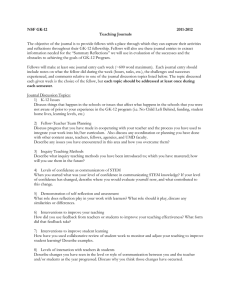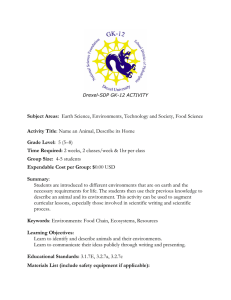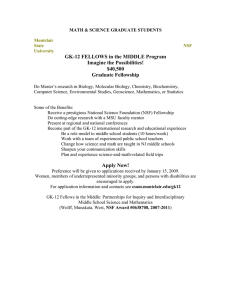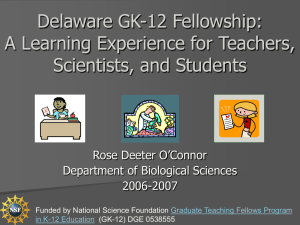NSF GK-12 Program Must be Saved: What You Can Do to Help
advertisement
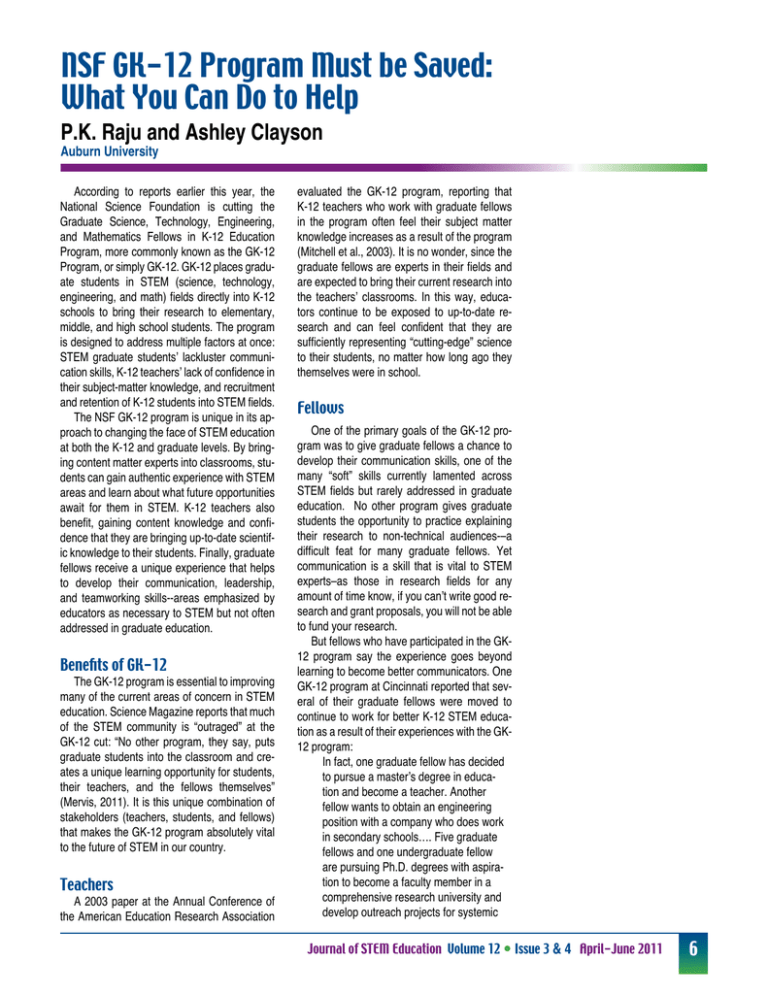
NSF GK-12 Program Must be Saved: What You Can Do to Help P.K. Raju and Ashley Clayson Auburn University According to reports earlier this year, the National Science Foundation is cutting the Graduate Science, Technology, Engineering, and Mathematics Fellows in K-12 Education Program, more commonly known as the GK-12 Program, or simply GK-12. GK-12 places graduate students in STEM (science, technology, engineering, and math) fields directly into K-12 schools to bring their research to elementary, middle, and high school students. The program is designed to address multiple factors at once: STEM graduate students’ lackluster communication skills, K-12 teachers’ lack of confidence in their subject-matter knowledge, and recruitment and retention of K-12 students into STEM fields. The NSF GK-12 program is unique in its approach to changing the face of STEM education at both the K-12 and graduate levels. By bringing content matter experts into classrooms, students can gain authentic experience with STEM areas and learn about what future opportunities await for them in STEM. K-12 teachers also benefit, gaining content knowledge and confidence that they are bringing up-to-date scientific knowledge to their students. Finally, graduate fellows receive a unique experience that helps to develop their communication, leadership, and teamworking skills--areas emphasized by educators as necessary to STEM but not often addressed in graduate education. Benefits of GK-12 The GK-12 program is essential to improving many of the current areas of concern in STEM education. Science Magazine reports that much of the STEM community is “outraged” at the GK-12 cut: “No other program, they say, puts graduate students into the classroom and creates a unique learning opportunity for students, their teachers, and the fellows themselves” (Mervis, 2011). It is this unique combination of stakeholders (teachers, students, and fellows) that makes the GK-12 program absolutely vital to the future of STEM in our country. Teachers A 2003 paper at the Annual Conference of the American Education Research Association evaluated the GK-12 program, reporting that K-12 teachers who work with graduate fellows in the program often feel their subject matter knowledge increases as a result of the program (Mitchell et al., 2003). It is no wonder, since the graduate fellows are experts in their fields and are expected to bring their current research into the teachers’ classrooms. In this way, educators continue to be exposed to up-to-date research and can feel confident that they are sufficiently representing “cutting-edge” science to their students, no matter how long ago they themselves were in school. Fellows One of the primary goals of the GK-12 program was to give graduate fellows a chance to develop their communication skills, one of the many “soft” skills currently lamented across STEM fields but rarely addressed in graduate education. No other program gives graduate students the opportunity to practice explaining their research to non-technical audiences-–a difficult feat for many graduate fellows. Yet communication is a skill that is vital to STEM experts–as those in research fields for any amount of time know, if you can’t write good research and grant proposals, you will not be able to fund your research. But fellows who have participated in the GK12 program say the experience goes beyond learning to become better communicators. One GK-12 program at Cincinnati reported that several of their graduate fellows were moved to continue to work for better K-12 STEM education as a result of their experiences with the GK12 program: In fact, one graduate fellow has decided to pursue a master’s degree in education and become a teacher. Another fellow wants to obtain an engineering position with a company who does work in secondary schools…. Five graduate fellows and one undergraduate fellow are pursuing Ph.D. degrees with aspiration to become a faculty member in a comprehensive research university and develop outreach projects for systemic Journal of STEM Education Volume 12 • Issue 3 & 4 April-June 2011 6 reform in K-12 STEM education (Kinne et al., 2004). These results may not be representative of all GK-12 programs across the nation, but many fellows have expressed their passionate support for the program as a result of their valuable experiences. One past fellow states: I learned so much as a GK-12 fellow. I learned how to tell kindergarteners why polo verde trees have green bark in such a way that they actually absorbed it…. I learned to be patient….I learned how to communicate with K-8 teachers and learned about some of the many trials they face in their profession. I learned how ill-informed and science illiterate many elementary school teachers are. I learned to work with a group of dedicated naturalists as they desperately attempted to keep their center going in the face of budget cuts…. And I learned how very, very much I enjoyed teaching people of all ages about insects (Goforth, 2011). No other program gives graduate students these types of opportunities. No other program gives graduate students the chance to see science education at work today, and perhaps reflect upon their own memories from the K-12 classroom. No other program sets graduate students on fire for K-12 education as the GK12 program does. Not every fellow will emerge with the same passion as the aforementioned students, certainly, but it certainly gives them a chance to become a catalyst for change. What was intended to be simply an exercise in communication can become so much more. Students And let’s not forget the students. They benefit perhaps most of all, and not just in content matter knowledge. Recruitment and retention, in particular, benefit from the program uniquely. Students in classrooms with GK-12 graduate students get a chance to see first-hand the exciting opportunities that STEM career paths provide. And they get to witness it from fellow students, people not much older than they are. High school students especially benefit from seeing graduate students in the classroom– people they can relate to more so than older full professors who may attempt to engage in recruitment efforts. Graduate students, simply by being younger, can motivate high school students and engage them in ways that others cannot. GK-12 programs across the nation report recruitment efforts in a number of different fields. One program offered a free computer camp to middle school students designed to both increase their general comfort level with computers and to expose them to potential career paths involving computers (Miller, Shearer, & Moskal, 2005). Lessons included web design, robotics, global positioning systems, video game creation, and graphic animation. Students from a variety of socioeconomic statuses were exposed to these fields, not just those who can afford to pay for summer camp experiences. Some programs measured their successes in affecting students’ STEM self-efficacy and interest (Rust, Richardson, Davis, Soled, & Heckel, 2006). Participants in one activity of the aforementioned GK-12 program in Cincinnati reported a 50% increase in their interest in engineering. Eighty-three percent of students felt more confident in their ability to learn math and science after the activity. One five-year GK-12 program in Bangor, Maine utilized university, high school, and community resources to make an unprecedented impact on the local community (Doore, et al., 2008). The project used the subject matter of sensors to bring a variety of subjects, including into high school classrooms. The students adopted real-world projects with implications to their community, including emergency services, public safety personnel, and the local Bangor Museum and Center for History. The subject of sensors was so successful at Bangor High School that one GK-12 fellow developed the curriculum for a permanent Geographic Information Systems (GIS) course, which was later approved by the Bangor School Board and implemented beginning in 2006. Eighty-one percent of the students in the 2006 - 2007 GIS class reported that GIS was their favorite content area, though 50% also reported that math and science were their least enjoyable classes. Thus, the GK-12 program was able to reach students typically uninterested in–maybe even intimidated by–STEM classes and demonstrate real-world applications of those subjects. A Unique Combination As the editors of this journal, we believe that because of the unique combination of benefits of GK-12, it is imperative that the program continues to grow and develop–instead of getting the axe. No other program consistently reaches such a diverse range of stakeholders and Journal of STEM Education Volume 12 • Issue 3 & 4 April-June 2011 7 achieve such a wide range of goals simultaneously. Ideally, the GK-12 program will remain intact and funding will not be cut. The next best solution, however, would be to incorporate GK12 principles and practices into current NSF grant opportunities. Funding priority should be given to PIs who demonstrate willingness to incorporate these principles into their projects. But maybe it won’t get that far. We sincerely hope GK-12 can be saved. We urge each and every one of you to take any action you can to help save the GK-12 program. For those of you who use social media, seek out the “Save GK-12” community on Facebook. Or just send a brief email or letter to your senators or representatives encouraging them to support the GK-12 program. And as always, continue providing the outstanding research, teaching, and outreach to your respective institutions. The future of STEM education depends on it. We would like to hear from you on this policy issue. Please email us your comments and suggestions to rajupol@auburn.edu. We look forward to hearing from you. References Doore, S., Chernosky, M., Hedefine, E., Smith, J., Arsenault, J., Godsoe, S., Holden, C., et al. (2008). University of Maine GK-12 Sensors! Program Benefits a Local Community. 38th ASEE/IEEE Frontiers in Education Conference. Presented at the Frontiers in Education Conference, Saratoga Springs, NY: IEEE. Retrieved from http://ieeexplore.ieee.org/stamp/stamp. jsp?tp=&arnumber=4720534 Goforth, C. (2011, March 14). Why we should save the GK-12s. The Dragonfly Woman. Retrieved June 7, 2011, from http://dragonflywoman.wordpress.com/2011/03/14/ why-we-should-save-the-gk-12s/ Jeffers, A., Safferman, A., & Safferman, S. (n.d.). Understanding K - 12 Engineering Outreach Programs. Journal of Professional Issues in Engineering Education and Practice, April 2004, 95 - 108. Kinne, D., Kukreti, A., Fowler, T., Davis, K., Islam, S., Miller, R., Prather, E., et al. (2004). Work in Progress: Successes and Lessons Learned from a GK-12 NSF Grant Project. 34th ASEE/IEEE Frontiers in Education Conference. Presented at the Frontiers in Education Conference, Savannah, GA: IEEE. Retrieved from http://ieeexplore.ieee.org/stamp/stamp. jsp?tp=&arnumber=1408768 Mervis, J. (2011, March). Outrage Greets NSF Decision to End STEM Fellows Program. Science Magazine, 331: pp. 1127. Miller, L., Shearer, S., & Moskal, B. (2005). Technology Camp 101: Stimulating Middle School Students’ Interests in Computing. 35th ASEE/IEEE Frontiers in Education Conference. Presented at the ASEE/ IEEE Frontiers in Education Conference, Indianapolis, IN: IEEE. Retrieved from http://ieeexplore.ieee.org/stamp/stamp. jsp?tp=&arnumber=1612186 Mitchell, J. Levine, R., Gonzalez, R., Bitter, C., Webb, N. & White, P. (2003). Evaluation of the National Science Foundation Graduate Teaching Fellows in K-12 Education (GK12) Program. Paper presented at theAnnual Conference of the American Education Research Association. (Chicago, Illinois). Rust, M., Richardson, B., Davis, K., Soled, Susan, & Heckel, P. (2006). Work in Progress: Introducing Electrical and Computer Engineering to High School Math and Science Students. 36th ASEE/ IEEE Frontiers in Education Conference. Presented at the Frontiers in Education Conference, San Di: IEEE. Retrieved from http://ieeexplore.ieee.org/stamp/stamp. jsp?tp=&arnumber=4117053 P.K. Raju is the Thomas Walter Distinguished Profes- sor of Mechanical Engineering at Auburn University. He has made significant research contributions in acoustics, noise control, nondestructive evaluation, and engineering education. He has published 17 books, 8 book chapters and 160 papers in journals and conference proceedings. He received several awards for his work in the area of case studies in engineering education. Dr. Raju is the director of the Laboratory for Innovative Technology and Engineering Education (LITEE) and the Auburn Engineering Technical Assistance Program (AETAP). He is a Fellow of ASEE, ASME, the Institution of Engineers, India, and the Acoustical Society of India. Dr. Raju is the Editor-in-Chief of the Journal of STEM Education: Innovations and Research. Ashley Clayson recently graduated from Auburn University with a Master of Technical and Professional Communication. Her research interests include engineering communication, human-computer interaction, genre studies, and communication pedagogy. This fall, she will begin work on her doctoral degree at the University of Minnesota. Ms. Clayson is the Editorial Assistant for the Journal of STEM Education: Innovations and Research. Journal of STEM Education Volume 12 • Issue 3 & 4 April-June 2011 8
